 |
Ferranti Transistor Portable PT1010 U.K. 1958 |
 |
 Description
Description Restoration
Restoration |
 |
 Descrizione
Descrizione Restauro
Restauro |
|||||||
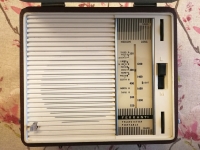 |
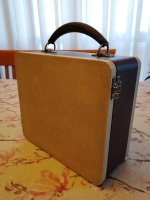 |
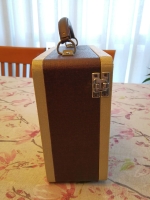 |
 |
||||||
|
In the mid-1950s, the British company decided to use semiconductors (transistors) in the design of a portable radio, but to avoid making a mistake, in 1958 Ferranti preferred to market its new device, the BPT333 model, through its subsidiary EKCO, which later became Ferranti Radio & Television Ltd., and the PT1010 radio model. Despite fears, transistor (or solid-state) radios immediately achieved great success, thanks especially to their smaller size and weight compared to valve devices, their lower fragility and, above all, their very low consumption, which meant long battery life and therefore lower running costs. The PT1010 was a superheterodyne receiver employing six germanium transistors (XA102, XA101, XA101, XB103, XC101, XC101) built by Ediswan (Siemens Edison Swan Electric Co. London). The radio was inserted in a wooden cabinet made like a briefcase and covered in imitation leather, a solution also adopted by other English companies which in those years were building tube and transistor radios. The antenna was a coil wound on a long ferrite core, the Medium Frequency resonated at 470 KHz and the audio amplifier consisted of a transistor XB103 followed by a push-pull of XC101. The PT1010 was equipped with a five inch diameter speaker which ensured good sound reproduction. Power was supplied by a 6V PP1 type battery. The dimensions were: 8.75 x 3.75 x 7.75 inch, and the weight was 4 lb 11.6 oz. IK3HIA © 2023 |
|||||||||
|
Return to top of page
|
|||||||||
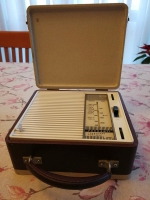 |
 |
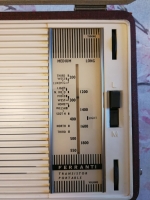 |
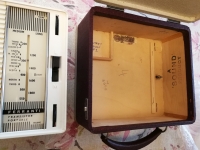 |
||||||
|
A metà degli anni cinquanta, la ditta britannica decise di utilizzare i semiconduttori (transistor) nella progettazione di una radio portatile, ma per non rischiare passi falsi nel 1958 la Ferranti preferì commercializzare il suo nuovo apparecchio modello BPT333 attraverso la controllata EKCO che poi divenne Ferranti Radio & Television Ltd. e il modello della radio PT1010. Non ostante i timori le radio a transistor (o a stato solido) ottennero subito un grande successo, grazie specialmente alle ridotte dimensioni e al peso rispetto a quelli degli apparecchi a valvole, alla minore fragilità e soprattutto per il consumo ridottissimo, che significava lunga durata delle batterie e quindi minor costo di gestione. La PT1010 era un ricevitore supereterodina che impiegava sei transistor al germanio (XA102, XA101, XA101, XB103, XC101, XC101) costruiti dalla Ediswan (Siemens Edison Swan Electric Co. Londra). La radio era inserita in un mobiletto di legno fatto a valigetta e rivestito in similpelle, una soluzione adottata anche da altre ditte inglesi che in quegli anni costruivano radio a valvole e a transistor. L'antenna era una bobina avvolta su un lungo nucleo di ferrite, la Media Frequenza risuonava a 470 KHz e l'amplificatore audio era costituito da un transistor XB103 seguito da un push-pull di XC101. La PT1010 era dotata di un altoparlante del diametro di 12,7 cm che assicurava una buona riproduzione sonora. L'alimentazione era fornita da una batteria tipo PP1 da 6V. Le dimensioni erano: 22,2 x 9,5 x 19,7 cm e il peso era di 2,145 Kg. IK3HIA© 2023 |
|||||||||
 |
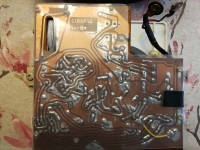 |
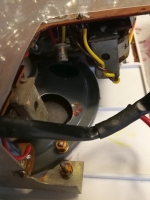 |
 |
||||||
|
Back to the top of the page >>
|
|||||||||
|
Since the radio was working properly, apart from a good general cleaning and a spray of deoxidizing spray on the volume potentiometer and the MW/LW switch, I decided not to carry out any further interventions and to leave the original electrolytic capacitors in the circuit. During the day the OM range is now almost deserted, but from my city I can pick up at any time Radio Koper (Radio Capodistria in Slovenian) which transmits at 549 kHz and the private radio Amica Radio Veneta which transmits from Vigonza (Padova) on 1017 kHz. After sunset and at night the listening possibilities multiply and with the Ferranti PT1010 you can tune in many broadcasts on Medium Waves and some even on Long Waves, coming from all over Europe and the Middle East. © IK3HIA 2023 |
|||||||||
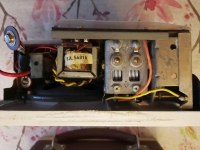 |
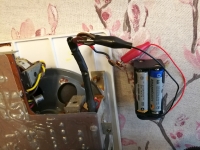 |
 |
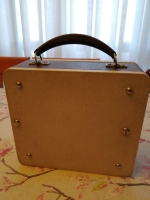 |
||||||
|
Return to top of page
|
|||||||||
|
Visto che la radio funzionava a dovere, a parte una bella pulizia generale e una spruzzata di spray disossidante nel potenziometro del volume e nel commutatore OM/OL, ho deciso di non effettuare ulteriori interventi e di lasciare nel circuito i condensatori elettrolitici originali. Durante il giorno la gamma OM è ormai pressoché deserta, ma dalla mia città riesco a captare a qualsiasi ora Radio Koper (Radio Capodistria in lingua slovena) che trasmette a 549 kHz e la radio privata Amica Radio Veneta che trasmette da Vigonza (Padova) sui 1017 kHz. Dopo il tramonto e di notte le possibilità di ascolto si moltiplicano e con la Ferranti PT1010 si possono sintonizzare molte trasmissioni in Onde Medie e qualcuna anche in Onde Lunghe, provenienti da tutta Europa e dal Medio Oriente. © IK3HIA 2023 |
|||||||||
|
Wiring diagrams and technical information
|
|||||||||
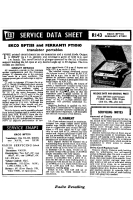 |
 |
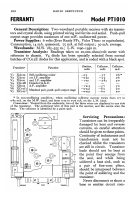 |
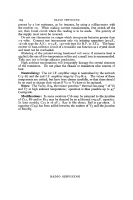 |
||||||
Return to top of page
![]() Torna a inizio pagina
Torna a inizio pagina
|
|
Return to: IK3HIA home page |
|
Return to: Transistor Radio |
|
Go to: Transistor diagrams |